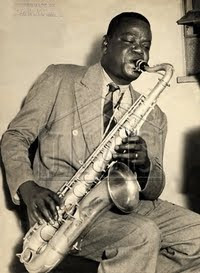Benê, o Flautista
 Benedito Lacerda (1903-1958) was a highly talented and skilled flutist, composer and leader of a famous regional that accompanied numerous singers and instrumentalists of the 1930s and 1940s in Brazil. Today Benedito Lacerda perhaps is mostly remembered for his co-oporation with Pixinguinha during the 1940s, their interplay on recordings from that decade added a new dimension to choro and remains exemplary samples of the level of virtuosity that choro performances had achieved. However, this musical aspect of the co-oporation between Lacerda and Pixinguinha has from time to time been neglected by critics, who instead have focused on Lacerda's role as a business manager due to the fact that Lacerda supported Pixinguinha by finance and promotion in return of having his own name added on some of Pixinguinha's compositions.
Benedito Lacerda (1903-1958) was a highly talented and skilled flutist, composer and leader of a famous regional that accompanied numerous singers and instrumentalists of the 1930s and 1940s in Brazil. Today Benedito Lacerda perhaps is mostly remembered for his co-oporation with Pixinguinha during the 1940s, their interplay on recordings from that decade added a new dimension to choro and remains exemplary samples of the level of virtuosity that choro performances had achieved. However, this musical aspect of the co-oporation between Lacerda and Pixinguinha has from time to time been neglected by critics, who instead have focused on Lacerda's role as a business manager due to the fact that Lacerda supported Pixinguinha by finance and promotion in return of having his own name added on some of Pixinguinha's compositions. Whatever the point-of-view in this controversial matter, this aspect cannot errase the fact that Lacerda was a great musician and that his legacy of musical compositions (over 700) and recordings (over 1000) is a notable chapter in the story of choro and MBP.
Perceiving this fact, a new cd-set containing 4 cds featuring recordings by Lacerda has just been released in Brazil. I have not yet had the opportunity to listen to this set, but I'll point you to find more info following the link in headline. This release is definitely of historic importance, if you are interested in the evolvement of choro and MBP.
 I add a quoted extract from Alvaro Neder's artist profile in AMG below
I add a quoted extract from Alvaro Neder's artist profile in AMG below"Benedito Lacerda began to learn the flute at age eight, by ear. While still very young, he joined the Banda Aurora. At 17 he moved with his family to Rio, where he started formal flute studies. He graduated from the National Music Institute, in flute and composition. From 1923 to 1925 Lacerda was a member of the band of the military police. In his final year there he was promoted to soloist. Discharged in 1927, he became a professional musician, performing in orchestras and theaters. In 1929 he was a member of the regional (small ensemble) Boêmios da Cidade, which accompanied Josephine Baker.
In the early '30s Lacerda formed his own group, Gente do Morro (name provided by Sinhô). As a singer, he recorded seven songs through Brunswick, accompanied by Gente do Morro. The group, which had a strong point in its percussive section, also accompanied other singers in several recording companies, and recorded some instrumental songs as well. Soon it dissolved, giving birth to Regional de Benedito Lacerda. This group had a remarkable career as a soloist group and in the accompaniment of important singers (such as Carmen Miranda, Francisco Alves, Orlando Silva, Sílvio Caldas, and others) and instrumentalists, on the radio, and in recordings (where they appeared many times as Boêmios da Cidade).
Around 1940 Lacerda was famous and successful, performing regularly in the sophisticated casinos of Rio. Pixinguinha, who was in a bad phase economically, offered his own choro compositions to Lacerda, who would sign them as partner, in exchange for his excellent promotion work. Among the choros recorded for Victor (where Lacerda was director), there are "Sofres Porque Queres," "Proezas de Sólon," "Só pra Moer," "Canhoto," "Um a Zero," "Descendo a Serra," and others. Playing together with Pixinguinha gave Lacerda the opportunity for the great master to revolutionize Brazilian music through the counterpoints devised by Pixinguinha on the tenor sax (an instrument more appropriate to his style of embouchure, at the time). In 1950, Benedito Lacerda retired and the group was then led by Canhoto, as Regional do Canhoto."
I found a video fragment featuring a young flutist performing a solo version of one of the famous co-operative compositions by Pixinguinha and Lacerda, "Vou vivendo"
Jo



0 Comments:
Post a Comment
<< Home